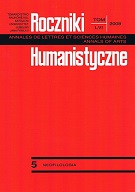Phonology Out of Work – the -igh ∼ -í Alternation in Modern Irish
Phonology Out of Work – the -igh ∼ -í Alternation in Modern Irish
Author(s): Maria Bloch-TrojnarSubject(s): Language and Literature Studies
Published by: Towarzystwo Naukowe KUL & Katolicki Uniwersytet Lubelski Jana Pawła II
Keywords: morphophonology; alternation; verbal nouns in Irish; morfofonologia; alternacja; rzeczownik odsłowny w języku irlandzkim
Summary/Abstract: The verbal noun (henceforth VN) is one of the most important and at the same time most complex categories in Modern Irish, on account of its multifarious functions and complicated formation, which involves about 20 morphophonological exponents. Synchronically, these exponents are not on equal footing. Any account of various terminations marking VNs must make a distinction between productive desinences, whose attachment is subject to pure grammatical conditioning and unproductive ones, which have fallen into desuetude and whose attachment is regulated by lexical marking, in which case any concomittant alternations are not rule governed and represent fossilised remnants of inert phonological rules. The latter will comprise isolated examples such as, e.g. dubhaigh ‘blacken’ – dúchan, tuig ‘understand’ – tuiscint. Cases of suppletion such as deir ‘say’ – rá , teir ‘go’ – dul constitute one end of this productivity cline, whereas regular formations the other. In the elsewhere block of regular affixation rules operating on verbal roots we find two rules which apply to verbs belonging to a specific conjugation. The default markers are [Ə] and [u:] for the first and second conjugation respectively. The aim of the paper is to weigh the pros and cons for regarding the morphemically conditioned alternation [ig′ ~ i:] observed in the verbal root of some 1st conjugation verbs and their corresponding VNs ( i.e. nigh ‘wash’ – ní) as automatic. In the paper we shall try to decide whether the regular rule of VN formation referred to above also subsumes monosyllabic verbs which end in -igh and the long vowel [i:] in the VN is a phonological reflex of – Ə attachment to the root, e.g. nigh + Ə → ní. If this is not the case, and we do not have to do with an automatic phonological process consisting in the delinking of the palatalised stop [g′] and attendant compensatory lengthening of the preceding vowel, the stem alternation nigh – ní should be viewed as morphologically motivated and as such comes within the purview of the lexicon.
Journal: Roczniki Humanistyczne
- Issue Year: 56/2008
- Issue No: 05
- Page Range: 63-74
- Page Count: 12
- Language: English

